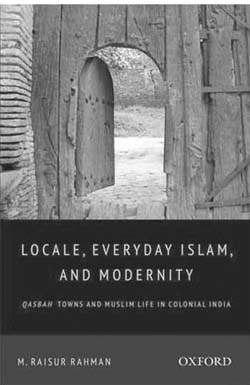From the thirteenth century onward, cities played a central role in the emergence, consolidation and subsequent expansion of Muslim power across large sways of the Indian subcontinent. The Delhi Sultanate (1206–1526), the Mughal Empire (1526– 1857), as well as smaller medieval Muslim principalities such as the sultanates of the Deccan, revolved around urban agglomerations that were simultaneously seats of power, centers of learning and economic hubs. The intimate relations of Indian Muslims with the urban environment remains epitomized, to this day, by the takhallus (nom de plume) of many Urdu poets, which showcases their belonging to a particular city. And as the decline of Muslim power was being reflected in the decay of the glorious cities of yore, a specific genre of Urdu poetry, the shahr-e-ashob (lament for the city), came to synthesize these urbane anxieties. Rather than of the city per se, however, the most prominent figures of this late-Mughal poetry (Mirza Sauda, Shah Hatim, Mir Taqi Mir…) were eulogists of imperial cities (Delhi, in particular) imagined by their rulers as worthy rivals for the great metropolises of Central Asia and Persia. Thus, for all the material comfort that they found in nawabi Lucknow, poets like Mir continued to crave for Delhi’s lights, even as the latter had begun to fade.1
This infatuation with imperial cities did not remain a form of poetic mannerism. It is also reflected in the postcolonial historiography of Islam in India, where imperial urban centers like Delhi/ Shajahanabad and, to a lesser extent, capitals of Princely States such as Hyderabad and Lucknow have received much more scholarly attention than smaller, less prestigious urban settlements with a significant Muslim presence.2
In line with some recent works—such as Justin Jones’s groundbreaking study of religious reform in colonial Amroha3 —but on a grander scale (if only for the comparative scope of his study), Raisur Rahman’s book aims to fill these historiographical gaps and to project new light on Muslim engagements with modernity from the vantage point of North Indian qasbah towns in the last quarter of the nineteenth and early twentieth century. In the Indian context, the term qasbah (from the Arabic ‘to divide’ or ‘to cut up’) primarily refers to the small towns that developed in the Rohilkhand and Awadh regions of present-day Uttar Pradesh, under the auspices of a landed Muslim gentry which, in its heyday, patronized arts and letters, as well as various service castes devoted to its leisurely activities and general wellbeing. These small urban settlements played the role of administrative headquarters for successive governments, and various officials were stationed there for the purpose of revenue collection. As nodal points in the local rural economy, qasbahs also attracted traders and merchants who, along-with landholders, patronized professional and intellectual classes (teachers, jurists, poets, journalists,…). While these small market towns were socially and economically dominated by Muslims, their cultural outlook was also heavily influenced by Hindu customs, beliefs, and public events (fairs, festivals…). As a result of these prolonged and multifarious encounters, these qasbah towns have been one of the major laboratories of India’s ‘composite culture’, which to this day remains reflected in a general spirit of camaraderie (bhaichara) across religious boundaries.

